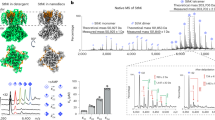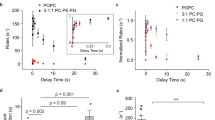Abstract
The regulation of ion channels by phosphatidic acid (a proposed active metabolite in the phosphatidylinositol effect) was investigated using1H-NMR spectroscopy and small unilamellar phospholipid vesicles. Transport across egg-yolk phosphatidylcholine (egg PC) and dipalmitoyl phosphatidylcholine (DPPC) vesicular membranes in the presence of the channel-forming ionophores alamethicin, melittin, and nystatin was monitored using the lanthanide probe ion Pr3+. In the absence of the ionophores, phosphatidic acid (PA) alone was found to have no ionophore properties, but in the presence of the ionophores the incorporation of 3 mol % phosphatidic acid in the bilayer markedly increased the rate of transport using melittin and nystatin, but decreased the rate using alamethicin, independent of the type of phosphatidylcholine used. The presence of PA in the bilayer also stimulated the production of lyric type channels, the extent of which were both ionophore- and lipid-dependent. These results are discussed in terms of possible molecular interactions between the PA, the individual ionophores, and type of lipid used.
Similar content being viewed by others
References
Berden JA, Barker RW & Radda GK (1975) Biochim. Biophys. Acta375, 186–208.
Bergelson LD (1978) in: Methods in Membrane Biology (Korn E, ed), vol 9, pp 257–335.
Billah MM & Michell RH (1979) Biochem. J.182, 661–681.
Boheim G & Kolb HA (1978) J. Membrane Biol.38, 99–150.
Cass A, Finkelstein A & Krespi V (1970) J. Gen. Physiol.56, 100–124.
Chauhan VPS, Ramsammy LS & Brockerhoff H (1984) submitted to Biochim. Biophys. Acta
Dawson RMC, Hemington NL & Irvine RF (1983) Biochem. Biophys. Res. Commun.117, 196–201.
Degani H, Simon S & Mclaughlin AC (1981) Biochim. Biophys. Acta646, 320–328.
Dufourcq J & Faucon J-F (1977) Biochim. Biophys. Acta467, 1–11
Eisenberg M, Kleinberg ME & Shaper JH (1977) Ann. N.Y. Acad. Sci.303, 281–291.
Fain JN & Berridge MJ (1979) Biochem. J.180, 665–681.
Fox RO & Richards FM (1982) Nature300, 325–330.
Georghiou S, Thompson M & Mukhopadhyay AK (1982) Biophys. J.37, 159–161.
Hanke W, Methfessel C, Wilmsen H-U, Katz E, Jung G & Boheim G (1983) Biochim. Biophys. Acta727, 108–114.
Holmes RP & Yoss NL (1983) Nature305, 637–638.
Hunt GRA (1980) Chem. Phys. Lipids27, 353–364.
Hunt GRA & Jawahalal K (1980) Biochim. Biophys. Acta601, 678–684.
Hunt GRA & Jones IC (1982) Biosci. Rep.2, 921–928.
Hunt GRA & Jones IC (1983) Biochim. Biophys. Acta736, 1–10.
Hunt GRA & Tipping LRH (1978) Biochim. Biophys. Acta507, 242–261.
Hunt GRA, Tipping LRH & Belmont MR (1978) Biophysical Chem.8, 341–355.
Hutton WC, Yeagle PL & Martin RB (1977) Chem. Phys. Lipids19, 255–265.
Michell RH & Kirk CJ (1981) Trends Pharmacol. Sci.2, 86–89.
Nayar R, Schmid SL, Hope MJ & Cullis PR (1982) Biochim. Biophys. Acta688, 169–176.
Nishizuka Y (1983) Phil. Trans. R. Soc. Lond.B202, 101–112.
Pierce HD Jr, Unran AM & Oehlschlager AC (1978) Can. J. Biochem.56, 801–807.
Putney JW, Weiss SJ, Van De Walle CM & Haddas RA (1980) Nature284, 345–347.
Salmon DM & Honeyman TW (1980) Nature284, 344–345.
Serhan CN, Anderson P, Goodman E, Dunham PB & Weissmann G (1981) J. Biol. Chem.256, 2736–2741.
Serhan CN, Fridovich J, Goetzl EJ, Dunham PB & Weissmann G (1982) J. Biol. Chem.257, 4746–4752.
Ting TZ, Hagan PS, Chan SI, Doll JD & Springer CS Jr (1981) Biophys. J.34, 189–216.
Tosteson MT & Tosteson DC (1981) Biophys. J.36, 109–116.
Tyson CA, Zande HV & Green DE (1976) J. Biol. Chem.251, 1326–1332.
Author information
Authors and Affiliations
Rights and permissions
About this article
Cite this article
Hunt, G.R.A., Jones, I.C. & Veiro, J.A. Phosphatidic acid regulates the activity of the channel-forming ionophores alamethicin, melittin, and nystatin: A1H-NMR study using phospholipid membranes. Biosci Rep 4, 403–413 (1984). https://doi.org/10.1007/BF01122505
Received:
Issue Date:
DOI: https://doi.org/10.1007/BF01122505




